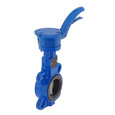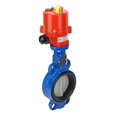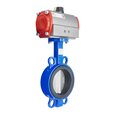Butterfly Valve Actuator Types and Selection Guide
.jpg)
Figure 1: Butterfly valve actuation mechanisms: manual (left), electric (middle), and pneumatic (right)
Choosing the right actuator for a butterfly valve ensures smooth operation, precise control, and long service life. The main actuator types are manual, electric, and pneumatic, and each has unique advantages depending on the system requirements.
Tameson engineers recommend evaluating factors such as cost, torque, automation level, speed, and operating environment when selecting an actuator. In short:
- Choose manual actuators if the valve is rarely operated or easily accessible.
- Choose electric actuators when precision and remote control are important.
- Choose pneumatic actuators for fast or frequent cycling in hazardous or industrial environments.
View our online selection of butterfly valves!
Different types of butterfly valve actuators
Table 1: Manual, electric, and pneumatic actuators for butterfly valves
| Parameter | Manual actuator | Electric actuator | Pneumatic actuator |
| Description | Operated with a lever or handwheel and gearbox | Has a motor to control the position of the valve disc | Uses compressed air to drive diaphragms connected to the valve stem |
| Key features | Low cost, easy to install, requires no external power |
|
|
| Limitations / Considerations | Difficult for frequent operation or remote/hard-to-reach locations |
|
|
| Typical applications | Used in water distribution, HVAC balance lines, and isolation service where the valve is adjusted only occasionally |
Ideal for automated systems requiring accurate positioning, such as HVAC automation, chemical dosing, water treatment, and clean processes (pharmaceutical, food, beverage) | Ideal for emergency shutoff, safety-critical systems, or high-pressure processes; used in gas service, slurry transport, steam applications, and hazardous/explosive environments |
FAQs
Is a butterfly valve a manual valve?
Yes. A butterfly valve can be manual when operated by a lever or handwheel. It can also be automated with electric or pneumatic actuators.
What is a manual lug type butterfly valve?
A manual lug-type butterfly valve has threaded lugs for bolting between flanges and is operated by hand.
Can I replace a manual actuator with an electric one?
Yes, if the valve is compatible and power is available. The electric actuator enables automation but requires wiring, mounting adaptation, and protection against moisture or explosive environments.









